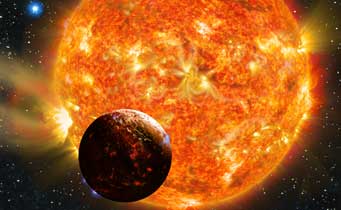Kepler-78b is now the smallest exoplanet with a known density.
This is what a roasted chestnut must feel like.

This artist's illustration shows a fanciful look at Kepler-78b, an Earth-size, Earth-mass planet orbiting its star in only 8.5 hours. (Don't let the illustration's perspective fool you: the star is 67 times wider than the planet.)
Karen Teramura / UHIfA
At 1.2 Earth radii and just under 2 Earth masses, Kepler-78b might sound appealing — until you realize that it’s orbiting so close to its parent star that it’s three times hotter than Mercury’s dayside. It skims less than two stellar radii above its star’s visible surface, a distance smaller than one-hundredth Earth’s distance from the Sun’s photosphere. In fact, if it were a comet, Kepler-78b would classify as a sungrazer: it’s about as far from its star as Comet ISON will be when it zooms past the Sun at the end of November.
Astronomers discovered Kepler-78b earlier this year, but the Kepler spacecraft’s observations only revealed the candidate planet’s width and orbit. The team did follow-up work from the ground to look for a wiggle in the star’s position from the planet’s gravitational tug, which would have allowed the team to calculate the planet’s mass. But the astronomers saw nothing conclusive and could only give an upper mass limit of 8 Earths.
Now two teams have independently spotted these tiny radial velocity wiggles in Kepler-78’s light. Andrew Howard (University of Hawaii at Manoa) and colleagues used the HIRES spectrograph at Keck on Mauna Kea; Francesco Pepe (Geneva Observatory, Switzerland) and colleagues used the new HARPS-N spectrograph — the Northern Hemisphere version of the spectacularly successfully HARPS in Chile — at Roque de los Muchachos Observatory in the Canary Islands. Both spotted wiggles corresponding to a couple of meters per second, they report online October 30th in Nature.
The teams calculated slightly different values for the planet’s parameters, but they’re easily within each other’s error bars. Combined, the mass and radius measurements give the planet’s density: between 5.3 and 5.57 grams per cubic centimeter (3.7 to 8.6 with error bars, but who’s counting). Earth’s density is 5.5 grams/cm3.
In other words, it’s a match.
The density implies that Kepler-78b is made of rock and iron. How it got to its current position is unknown; it couldn’t have formed there, because the star was a little fatter in its infancy and would have filled the space in which the planet now orbits. One idea is that it might be the core of a disrupted gas giant. However the planet did it, it won’t stay there for long: the star’s gravity should rip the planet apart within a few billion years.
Even until then, the planet’s existence is a harrowing one. The star is a slightly smaller and cooler version of the Sun but much younger, at about 700 million years. Stars at this tender age are active (think tempestuous toddlers) and Kepler-78 is awash with starspots. The planet’s snug hug would make the world a prime target for coronal eruptions.
References:
Andrew W. Howard et al. "A rocky composition for an Earth-sized exoplanet." Nature, 30 October 2013.
Francesco Pepe et al. "An Earth-sized planet with an Earth-like density." Nature, 30 October 2013.
 0
0
Comments
You must be logged in to post a comment.